We kicked off 2014 with Bethany Hegedus (owner and creative director of The Writing Barn, author) with her 10+ year journey to seeing Grandfather Gandhi published. Today we welcome Greg Neri, author of hard-hitting novels Yummy: The Last Days of a Southside Shorty, Surf Mules, Chess Rumble and more with the story behind the story of his new picture book biography of Johnny Cash, with his own 10+ year journey. We’re thrilled to welcome Greg as he shares how he says “no to no.”
The Resurrection of Johnny Cash
“Rejection”–there’s a word. Although in the publishing world, we tend to say “pass,” as in so-and-so passed. It makes it sound like someone died instead of rejecting you, so it goes down a little bit easier.
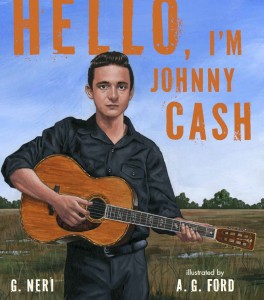 Hello, I’m Johnny Cash was supposed to be my ticket to the big leagues as a writer. Back in 2002, I had high hopes for this picture book biography. Why? Well, Johnny Cash was in the midst of one of the greatest comebacks in music history. He was a living legend and producing perhaps the best music of his life. But what really got my attention was reading Johnny’s handwritten liner notes from his American Recordings album in the ’90s that told an amazing tale that I’d never heard before. The story of his momma’s old beat-up guitar and how it formed his love of music and protected him from the harsh Depression-era years of his childhood. It had all kinds of details of his early years that I had no idea about. It made the hairs on my neck stand up and I couldn’t shake it.
Hello, I’m Johnny Cash was supposed to be my ticket to the big leagues as a writer. Back in 2002, I had high hopes for this picture book biography. Why? Well, Johnny Cash was in the midst of one of the greatest comebacks in music history. He was a living legend and producing perhaps the best music of his life. But what really got my attention was reading Johnny’s handwritten liner notes from his American Recordings album in the ’90s that told an amazing tale that I’d never heard before. The story of his momma’s old beat-up guitar and how it formed his love of music and protected him from the harsh Depression-era years of his childhood. It had all kinds of details of his early years that I had no idea about. It made the hairs on my neck stand up and I couldn’t shake it.
I was a fan of picture book biographies and, amazingly, no one had written Johnny’s yet. On top of that, there was a big Hollywood movie that had just been announced, so the timing would be perfect for a lot of attention. I dove in, and the more I uncovered about his childhood, the more astonished I was that nobody had taken up the task. Johnny’s life mirrored the history of America in the 20th century. He was a child of the Great Depression, saved by the New Deal, a dirt poor picked cotton picker, was inspired by the golden age of radio, became a radio operator in the Cold War decoding secrets from the Russians, received a Presidential Commendation, came home and found himself at the center of the birth of rock ‘n’ roll in Memphis, along with Elvis, Jerry Lee Lewis, Carl Perkins and others. He met Eleanor Roosevelt as a child, saw June Carter as a teen, and became pals with Elvis in his 20s. He had to overcome great hardships in a family of cotton farmers, shadowed by the death of his best friend and brother, Jack. He was a country boy who became a star—a true rags-to-riches, all-American dream story.
His two memoirs were haunting and powerful, and his voice came through just like his music—deep and unmistakably his. I wrote and wrote and the pages filled up. This was the first problem—there was too much story to tell. My first draft came in at 5,500 words, much too long for a picture book. But, inspired by Johnny’s voice, the writing was good, so I kept on cutting and editing.
Then the Man in Black died in the later part of 2003. Everyone was talking and writing about him. It was the perfect time to sell the first book for kids about this legend. So I shared scenes with my writing group, who encouraged me and told me where to focus. The word count went down—3,300, 2,500, 1,400 words. Then I stopped. I was losing too much gold. Any more and the story would suffer. I took it to SCBWI conferences, got encouragement from a consultation, got picked in a first page contest. I was confident, this was the one.
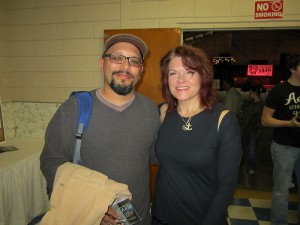
I needed an agent. So I went after the best. I’d seen this agent a few times at these conferences and knew he was the hot ticket (and a Cash fan). Taking advantage of an invitation to submit, I did. He was intrigued but had issues with it, raised questions and challenged me to revise. I did and sent it back. He sat on the fence, not entirely convinced. It just wasn’t there yet; eventually he passed.
But I didn’t take that sitting down. I thought maybe I’d try going straight to editors instead. So I started submitting. House after house was intrigued, but still, they passed. Too long for a picture book, too short for a bio. I kept at it, revising for the umpteenth time, and still no takers. Time was quickly passing. By the time the movie I Walk the Line came out, I had missed my chance. The tie-in to the movie was gone.
Tired of revising and chasing, frustrated that I’d missed my window of opportunity, I put it away and thought it would never see light of day.
Luckily, I’d written some other things in between the long waiting periods (namely a graphic novel called Yummy that had its own long journey to fruition as an abandoned screenplay I’d written in the ’90s), and I did get published shortly after with a totally different style and genre of writing. Graphic novels, free-verse novels. All gritty, urban and real. A far cry from Johnny Cash. It became my thing: stories for urban teens told in contemporary street voices. Life was good. But I kept thinking about Johnny, and in 2009 found myself signing books at a festival in Nashville next to his son, John Carter Cash. Even though the story was dead, I still wanted to talk to him, so when everyone left, we spoke. He’d written a picture book about his mother, so I was sure one about his dad would be forthcoming. I told him I’d tried for years but couldn’t crack his dad’s story. But he said he wasn’t planning on writing a picture book about his father. I kept thinking, too bad mine won’t see light of day.
A year or so later, I was living in Berlin, working on a novel. I was about to head out onto the road for several weeks and knew I wouldn’t be able to focus on a longer piece. So I went through my short story file and there it was, my piece about Johnny Cash. It had been years since I’d read it, so I took it with me and read it on the train.
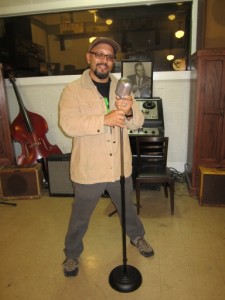
It was on that train ride (how Johnny Cash!) that I suddenly saw a new way to tell it. More like a song, one of those epic tall- tale songs that Johnny was known to sing. The focus would tell his story through music and only where music touched his life. A simple and obvious solution. I cut out anything that didn’t deal with music and started playing around with a free-verse style. Suddenly, the voice came and boom, within a couple days, I’d rewritten it in free-verse.
And it was good.
I sent it to my former editor, who was on semi-permanent maternity leave. Am I crazy or is this good? I asked. She agreed and had a few powerful, yet simple suggestions that took it to a whole other level. I polished it up and sent it to my current editor at Candlewick and she loved it. And just like that we made a deal, and now finally, in 2014, the book is here. Only 12 years later.
My biggest pleasure is seeing how gorgeous it is and how seamless it came together in the end, despite the long wait (which was even longer once we locked the text and the artist took over). I am perhaps more proud of this long journey of a book than any I’ve written. It is more beautiful than I could have imagined. And I even got to attend what would have been Johnny’s 80th birthday party in his tiny hometown of Dyess, where I met Rosanne Cash and many in the extended clan. All because I didn’t give up on it. I knew there was a great story to tell, I just needed to figure out how to tell it. And the funny thing is, the illustrator, A.G. Ford, is represented by the agent who passed so long ago. Life’s funny that way.
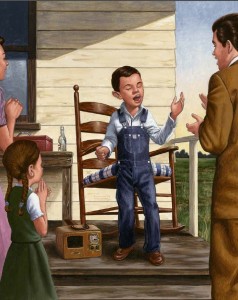
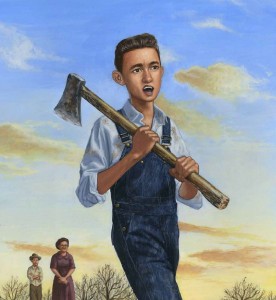 Johnny had his fair share of rejection being turned away by every club in Memphis because he played hillybilly music. He found a different venue and had to wear black to play there: a church. So fitting, and, of course, the Man in Black was born.
Johnny had his fair share of rejection being turned away by every club in Memphis because he played hillybilly music. He found a different venue and had to wear black to play there: a church. So fitting, and, of course, the Man in Black was born.
I’ve had much rejection in publishing, but I never gave in. I kept going because I believed, and that helped me find a different way which, in turn, informed who I’ve become as a writer. Books have a life (and schedule) all their own. You can’t force them, no more than you can force your child to be what you want. A story will have its ups and downs; you may even give up on them for a while. But eventually, they’ll come through, and when they do, you’ll realize it was all for a reason. Stories need to find their ways to the surface. Some just need longer to germinate. I now realize, had I sold that book way back in ’03/’04, I would have been a totally different writer and may have never discovered my true voice. So I guess it was meant to be.
The lesson: never give up on something. Just realize the time isn’t right and keep working on other things until your project finds its own way home.

G. Neri is the Coretta Scott King Award-winning author of Yummy: the Last Days of a Southside Shorty and the recipient of the Lee Bennett Hopkins Promising Poet Award for his free verse novella, Chess Rumble. His novels include his newly released Knockout Games, Surf Mules, and the Horace Mann Upstander Award-winning Ghetto Cowboy. Neri has been a filmmaker, animator, teacher and digital media producer. He currently writes full-time and lives on the Gulf Coast of Florida with his wife and daughter.

Terrific post! Congratulations, can’t wait to read the book!